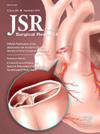Comparison of Reading Times of RFID-Tagged and Barcode-Engraved Surgical Instruments
IF 1.8
3区 医学
Q2 SURGERY
引用次数: 0
Abstract
Introduction
To improve patient safety and reduce burden on healthcare professionals and institutions, the individual management of surgical instruments is essential. There are two methods for individual item management: radio-frequency identification (RFID) and barcoding. However, there has been no examination of efficiency regarding reading times. Therefore, this study aimed to compare the reading times of RFID-tagged and barcode-engraved surgical instruments and evaluate the influence of operator proficiency.
Methods
The participants included 8 individuals and 41 surgical instruments from a varicose vein set. RFID tags and barcodes were attached to the surgical instruments. Five trials were conducted for each, and the reading times were measured.
Results
The reading times for RFID-tagged surgical instruments in the skilled and unskilled groups were 64.0 ± 9.0s and 79.4 ± 17.0 s, respectively, whereas those for barcode-engraved surgical instruments were 190.4 ± 28.1 s and 212.3 ± 40.3 s, respectively. Barcodes took 3.0 and 2.7 times longer to read than RFID-tagged instruments for the skilled and unskilled groups, respectively. Additionally, skilled operators using barcodes required 2.4 times more time than unskilled operators using RFID. Even nonmedical individuals were able to achieve quick and accurate readings with RFID. The estimated labor hours per person were $24,146-$42,322 for RFID and $71,078-$110,898 for barcode scanning for a year (working 8 h/d for 250 d).
Conclusions
RFID-tagged surgical instruments impose a lighter workload and financial burden than barcode-engraved surgical instruments. RFID technology may also improve patient safety due to less dependency on operator proficiency.
比较 RFID 标签和条形码刻印手术器械的读取时间。
导言:为了提高患者安全,减轻医护人员和医疗机构的负担,对手术器械进行单独管理至关重要。单个物品管理有两种方法:射频识别(RFID)和条形码。然而,目前还没有关于读取时间效率的研究。因此,本研究旨在比较 RFID 标签和条形码刻印手术器械的读取时间,并评估操作员熟练程度的影响:参与者包括 8 个人和 41 件静脉曲张手术器械。手术器械上分别贴有 RFID 标签和条形码。结果:贴有 RFID 标签的手术器械的读取时间短于贴有条形码的手术器械的读取时间:结果:熟练组和非熟练组的 RFID 标签手术器械的读取时间分别为 64.0 ± 9.0 秒和 79.4 ± 17.0 秒,而刻有条形码的手术器械的读取时间分别为 190.4 ± 28.1 秒和 212.3 ± 40.3 秒。熟练组和非熟练组读取条形码所需的时间分别是 RFID 标签器械的 3.0 倍和 2.7 倍。此外,使用条形码的熟练操作员所需的时间是使用 RFID 的非熟练操作员的 2.4 倍。即使是非医务人员也能使用 RFID 快速准确地读取数据。一年下来,RFID 的人均工时估计为 24,146 美元至 42,322 美元,条形码扫描的人均工时估计为 71,078 美元至 110,898 美元(250 天/天,每天工作 8 小时):RFID 标签手术器械比条形码标签手术器械的工作量和经济负担更轻。RFID 技术还可减少对操作人员熟练程度的依赖,从而提高患者安全。
本文章由计算机程序翻译,如有差异,请以英文原文为准。
求助全文
约1分钟内获得全文
求助全文
来源期刊
CiteScore
3.90
自引率
4.50%
发文量
627
审稿时长
138 days
期刊介绍:
The Journal of Surgical Research: Clinical and Laboratory Investigation publishes original articles concerned with clinical and laboratory investigations relevant to surgical practice and teaching. The journal emphasizes reports of clinical investigations or fundamental research bearing directly on surgical management that will be of general interest to a broad range of surgeons and surgical researchers. The articles presented need not have been the products of surgeons or of surgical laboratories.
The Journal of Surgical Research also features review articles and special articles relating to educational, research, or social issues of interest to the academic surgical community.

 求助内容:
求助内容: 应助结果提醒方式:
应助结果提醒方式:


